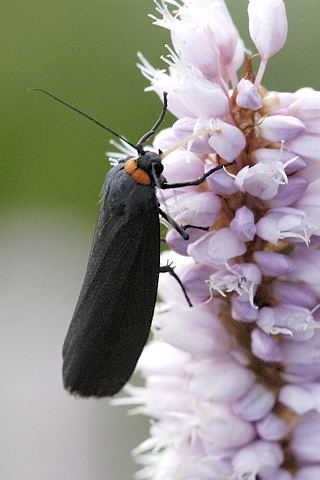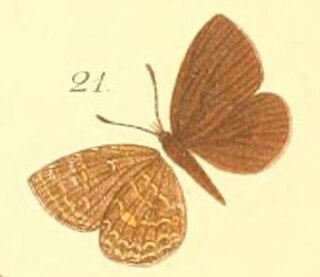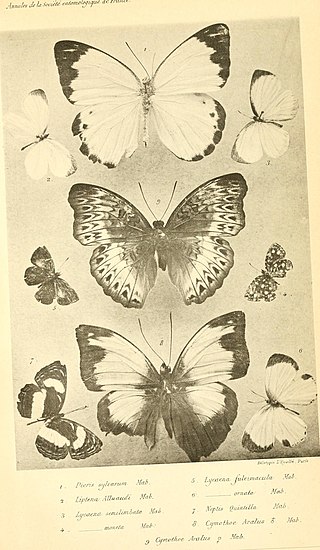In biology, a tribe is a taxonomic rank above genus, but below family and subfamily. It is sometimes subdivided into subtribes. By convention, all taxonomic ranks from genus upwards are capitalized, including both tribe and subtribe.

The Noctuidae, commonly known as owlet moths, cutworms or armyworms, are a family of moths. They are considered the most controversial family in the superfamily Noctuoidea because many of the clades are constantly changing, along with the other families of the Noctuoidea. It was considered the largest family in Lepidoptera for a long time, but after regrouping Lymantriinae, Catocalinae and Calpinae within the family Erebidae, the latter holds this title now. Currently, Noctuidae is the second largest family in Noctuoidea, with about 1,089 genera and 11,772 species. This classification is still contingent, as more changes continue to appear between Noctuidae and Erebidae.

The Nymphalinae are a subfamily of brush-footed butterflies. Sometimes, the subfamilies Limenitidinae, and Biblidinae are included here as subordinate tribe(s), while the tribe Melitaeini is occasionally regarded as a distinct subfamily.

The Arctiini are a tribe of tiger moths in the family Erebidae.

Hypocystina is a subtribe of butterflies.

The Proteaceae form a family of flowering plants predominantly distributed in the Southern Hemisphere. The family comprises 83 genera with about 1,660 known species. Australia and South Africa have the greatest concentrations of diversity. Together with the Platanaceae, Nelumbonaceae and in the recent APG IV system the Sabiaceae, they make up the order Proteales. Well-known 'Proteaceae genera include Protea, Banksia, Embothrium, Grevillea, Hakea and Macadamia. Species such as the New South Wales waratah, king protea, and various species of Banksia, Grevillea, and Leucadendron are popular cut flowers. The nuts of Macadamia integrifolia are widely grown commercially and consumed, as are those of Gevuina avellana on a smaller scale.

The Danaini are a tribe of brush-footed butterflies. The tribe's type genus Danaus contains the well-known monarch butterfly and is also the type genus of the tribe's subfamily, the milkweed butterflies (Danainae).

Melitaea is a genus of brush-footed butterflies. They are here placed in the tribe Melitaeini of subfamily Nymphalinae; some authors elevate this tribe to subfamily rank.

The Ophiusini are a tribe of moths in the family Erebidae.

The Eumaeini are a tribe of gossamer-winged butterflies. They are typically placed in the subfamily Theclinae, but sometimes considered a separate subfamily Eumaeinae. Over 1,000 species are found in the Neotropical realm

The Hypolycaenini are a small tribe of butterflies in the family Lycaenidae. It is alternatively treated as a subtribe, Hypolycaenina, of the Theclini.

The Lithosiini are a tribe of lichen moths in the family Erebidae. The taxon was described by Gustaf Johan Billberg in 1820.

The Mesosemiini are one of the tribes of metalmark butterflies. They are the basalmost living tribe of the Riodininae, outside the main radiation together with the slightly more advanced Eurybiini.

Epitolina is a genus of butterflies in the family Lycaenidae. Confusingly, it is also the name of a subtribe within the subfamily Poritiinae and the tribe Liptenini. Epitolina is endemic to the Afrotropical realm.

Though small in absolute diversity of genera, the Hemitheini are nonetheless the largest tribes of geometer moths in the subfamily Geometrinae. Like most Geometrinae, they are small greenish "emerald moths". The tribe was first described by Charles Théophile Bruand d'Uzelle in 1846.
Micrarctia is a tiger moth genus in the family Erebidae described by Seitz in 1910. The genus currently contains two species. Both species are found in central to western China, including the Chinese provinces of Qinghai and Sichuan.
Ypthima impura, the impure ringlet, is a butterfly of the family Nymphalidae. It is found in most of Sub-Saharan Africa.

Chlosyne leanira, the leanira checkerspot, is a butterfly of the family Nymphalidae. It is found in North America from western Oregon south to California, Nevada, Utah and western Colorado, as well as Baja California. The wingspan is 33–40 mm. Generally, females are larger than males, but males have a more apparent red color to their wings.

Morphini is a tribe of nymphalid butterflies in the subfamily Morphinae.

Liptena alluaudi, the Alluaud's liptena, is a butterfly in the family Lycaenidae. It is found in Guinea (Nimbas), Liberia, Ivory Coast, Ghana, Togo and western Nigeria. The habitat consists of forests. The name honours Charles Alluaud.


















